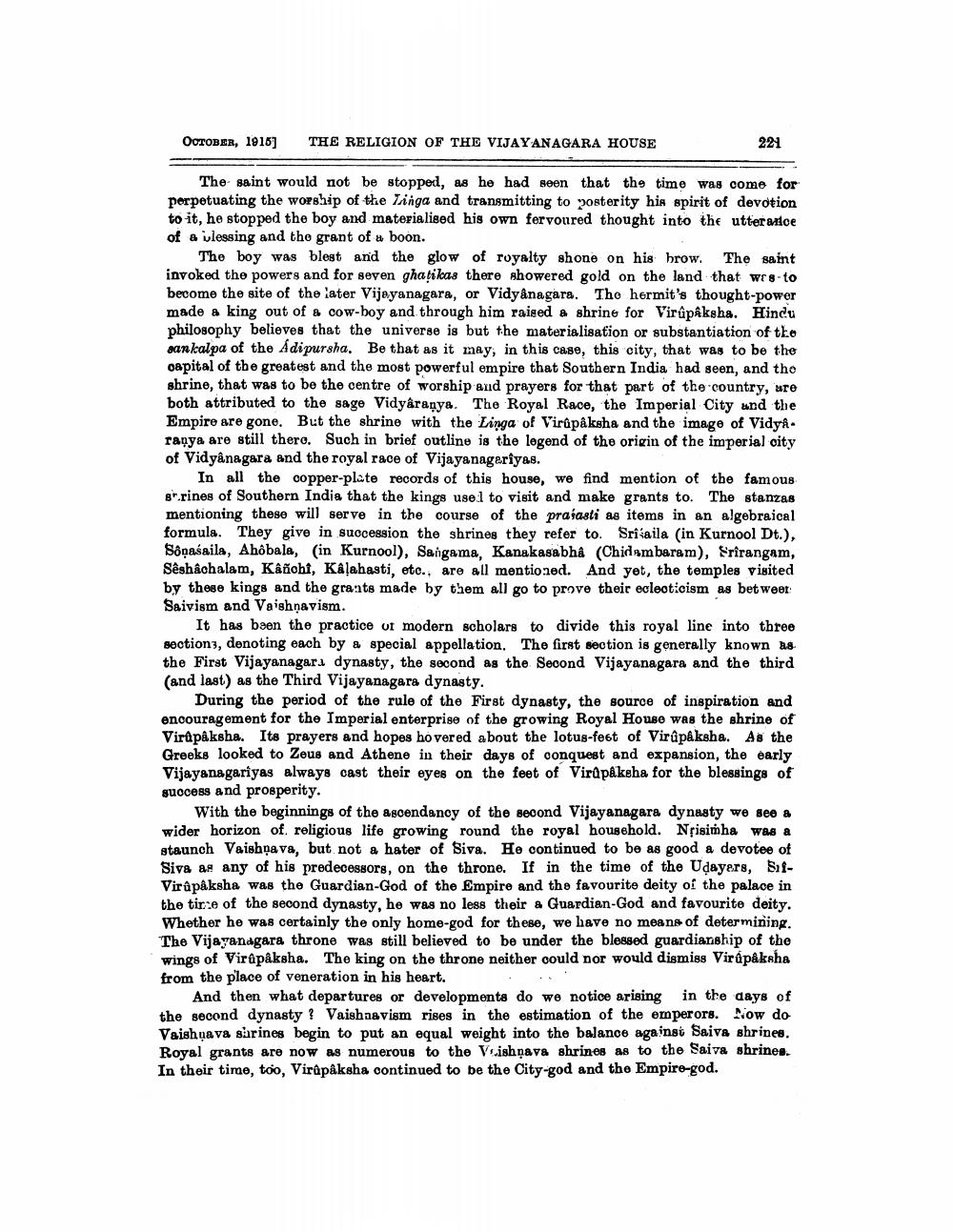________________
OCTOBER, 1916]
THE RELIGION OF THE VIJAYANAGARA HOUSE
221
.
The saint would not be stopped, as he had seen that the time was come for perpetuating the worship of the Tanga and transmitting to posterity his spirit of devotion to it, he stopped the boy and materialised his own fervoured thought into the utterance of a wlessing and the grant of boon.
The boy was blest and the glow of royalty shone on his brow. The saint invoked the powers and for seven ghatikas there showered gold on the land that was to become the site of the later Vijayanagara, or Vidyanagara. Tho hermit's thought-power made a king out of a cow-boy and through him raised a shrine for Virûpêksha. Hindu philosophy believes that the universe is but the materialisation or substantiation of the sankalpa of the Adipursha. Be that as it may, in this case, this city, that was to be the oapital of the greatest and the most powerful empire that Southern India had seen, and the shrine, that was to be the centre of worship and prayers for that part of the country, are both attributed to the sage Vidyâranya. The Royal Race, the Imperial City and the Empire are gone. But the shrine with the Linga of Virûpaksha and the image of Vidyâranya are still there. Such in brief outline is the legend of the origin of the imperial city of Vidyanagara and the royal race of Vijayanageriyas.
In all the copper-plate records of this house, we find mention of the famous 8.rines of Southern India that the kings use1 to visit and make grants to. The stanzas mentioning these will serve in the course of the prasasti as items in an algebraical formula. They give in succession the shrines they refer to. Srisaila (in Kurnool Dt.), Sônaśaila, Ahobala, (in Kurnool), Sangama. Kanakasabha (Chidambaram), Srirangam, Sêshâchalam, Kâñobi, Kalahasti, etc., are all mentioned. And yet, the temples visited by these kings and the grants made by them all go to prove their eclecticism as betweet: Saivism and Vaishnavism.
It has been the practice of modern scholars to divide this royal line into three sections, denoting each by a special appellation. The first section is generally known as the First Vijayanagari dynasty, the second as the Second Vijayanagara and the third (and last) as the Third Vijayanagara dynasty.
During the period of the rule of the First dynasty, the source of inspiration and encouragement for the Imperial enterprise of the growing Royal House was the shrine of Virapaksha. Its prayers and hopes ho vered about the lotus-feet of Virupaksha. As the Greeks looked to Zeus and Athene in their days of conquest and expansion, the early Vijayanagariyas always cast their eyes on the feet of Virupaksha for the blessings of success and prosperity.
With the beginnings of the ascendancy of the second Vijayanagara dynasty we see a wider horizon of religious life growing round the royal household. Npisimha was a staunch Vaishịava, but not a hater of Siva. He continued to be as good a devotee of Siva da any of his predecessors, on the throne. If in the time of the Udayers, SofVirâpâksha was the Guardian-God of the Empire and the favourite deity of the palace in the tirse of the second dynasty, he was no less their a Guardian-God and favourite deity. Whether he was certainly the only home-god for these, we have no means of determining. The Vijayanagara throne was still believed to be under the blessed guardianship of the wings of Virupaksha. The king on the throne neither could nor would dismiss Vir åpaksha from the place of veneration in his heart.
And then what departures or developments do we notice arising in the days of the second dynasty ? Vaishnavism rises in the estimation of the emperors. Now do Vaishnava sårines begin to put an equal weight into the balance against Saiva shrines. Royal grants are now as numerous to the Vishộava shrines as to the Saiva shrines. In their time, too, Virapaksha continued to be the City-god and the Empire-god.




